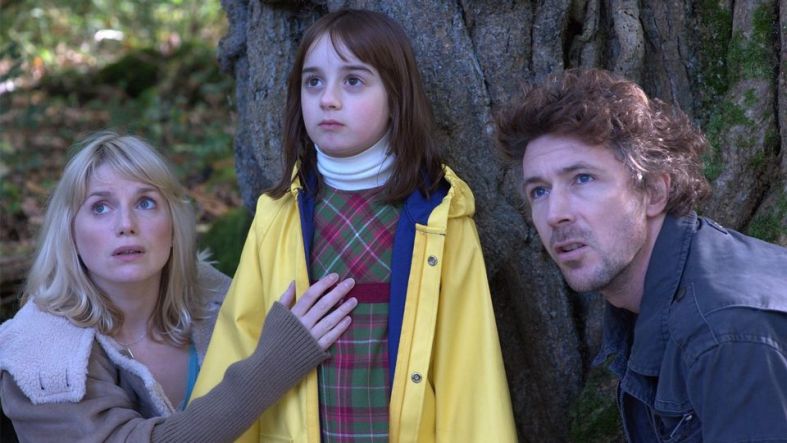Hammer’s Folk Horror ‘Wake Wood’ Makes Kids Scary

Hammer Film Productions is fabled within the horror community. The studio behind the resurgence of classic, monstrous icons in the mid-1950s, including Dracula and Frankenstein’s Monster, is part and parcel of the genre itself. Their films were vivid hybrids of old and new, cementing the studio—and its logo—as a surefire sign for fantastic, visceral horror. The studio declined in the late 1970s, and by the early 2000s, was all but a relic of the past. Curiously, Hammer returned in the early aughts with a new slate of horror films, with The Woman in the Black and Let Me In (Matt Reeves’ remake of Let the Right One In) ranking among the best (and most lucrative). Still, though, there were several other titles that, while lacking the budget or talent attached of the Hammer tentpoles, made a mark all their own. David Keating’s Wake Wood is one such output.
A folk horror riff on Stephen King’s enduringly influential Pet Sematary, Wake Wood is an austere “Monkey’s Paw” tale in the vein of Robin Hardy. Patrick and Louise Daley (Aidan Gillen and Eva Birthistle respectively) move to the rural town of Wakewood after the death of their daughter, Alice (Ella Connolly). Viciously mauled to death by a dog, Patrick and Louise hope to channel their grief into a new start. That desire is compounded by Louise’s infertility. Their first night there, Louise witnesses an odd pagan ritual at Arthur’s (Timothy Spall) home. But she keeps mum, not wanting to frighten Patrick more than necessary.
Also Read: ‘Troll 2’ Embodies Everything That Can Go Wrong With Folk Horror
After another death— by an animal in town—Keating leans heavily into the natural world’s quest for reclamation. Patrick and Louise are poised to leave, but Arthur catches them on their way out. Aware that Louise has seen his ritual, he makes her a deal. Stay, and he can bring their daughter back for three days. There are sundry caveats, including the three-day limit. Once brought back, Alice can only stay within the boundaries of Wakewood, she can’t have been dead for more than one year, and it all but consigns Patrick and Louise to living out the rest of their lives there. As bereaved parents are wont to do, they easily accept, eager to see Alice again.
The nitty-gritty is considerably darker than the Pet Sematary allusions might suggest. Not only do Patrick and Louise need a part of Alice’s corpse—and they get it, digging up her grave and severing a finger—but they also need a fresh corpse. Arthur does successfully procure one in town by way of tacit threats. With time, Alice is born again. Horror fans will have no trouble guessing what happens next. After Alice is scared over the boundaries of the town, she recovers, though Arthur and the other villagers—Wake Wood’s rendition of the Summerisle folk—insist she be sent back right away. They hear the three words no parent of a resurrected child wants to hear: something isn’t right.
Also Read: 5 Ultimate Found Footage Folk Horror Films
Alice sets about on her three-day murder spree, killing animals and other townspersons indiscriminately. Indeed, Patrick and Louise weren’t entirely honest about how long Alice had been dead. This perverts the ritual and renders Alice as an uncontrollable killing machine, quite literally a folksy Alice, Sweet Alice. The ending is a whopper, though not entirely unexpected (it’s lifted quite liberally from King’s aforementioned work). But it works. As a symbol of revitalized Hammer horror, Wake Wood is exactly what fans would want.
Everything about it feels gothic and precise. The folk horror elements call back to some of Hammer’s earlier offerings, including Captain Kronos: Vampire Hunter (1972) and The Devil Rides Out (1968). The constrained scale feels like an early template for the future development of horror, where budgets shrank but scares increased considerably. Better still, it makes effective use of some enduring horror tropes, namely the loss of a child. It’s a common horror concept because it’s among the most horrifying things to ever happen. Keating doesn’t shy away from the dark reality.
Also Read: ‘They’re Outside’: Exclusive Trailer Shows Off A Terrifying Mix of Found Footage and Folk Horror
Most curiously, though, is the rebranding of the pagan townsfolk. In the likes of “Harvest Home” and others, it’s the pagans themselves, a horror demonym for terrifying rituals and violent iconography, responsible for the horror and bloodshed. Keating reverses course, framing the outsiders, not the Wakewood residents, as the party ultimately responsible for the violence. They violate sacred rules on hallowed ground and spit in the face of centuries worth of folk tradition. These grieving parents perverted a gift given to them and are thus responsible for bearing the consequences.
It’s an interesting reversal, one that imbues Wake Wood with considerably more intrigue than it otherwise might have had. Additionally, in the genre’s own wake of folk horror, it’s a compelling progenitor perhaps a bit too ahead of its time. Released in 2011, Wake Wood would undoubtedly dominate the horror zeitgeist, no differently than You Are Not my Mother or You Won’t Be Alone. With springtime on the horizon, it’s never been a better time to dig up the corpse of a sensational, underrated folk horror movie and resurrect it for your viewing pleasure.
Categorized:Editorials News

